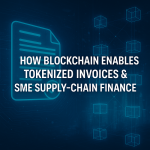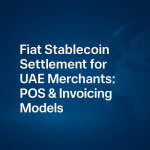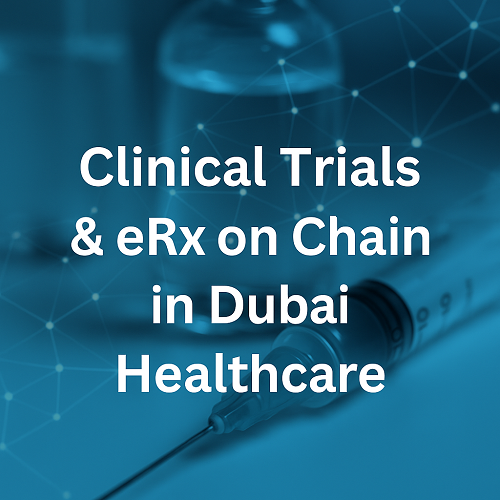Introduction
Dubai is rapidly positioning itself as a global proving ground for digitally transformed healthcare. From nationwide health information exchanges to emirate-level consent and access controls, the region’s infrastructure is now mature enough to support blockchain clinical trials Dubai and end-to-end e-prescription (eRx) traceability. For health systems, pharma sponsors, CROs, pharmacies, and insurers, blockchain can harden data integrity, streamline consent, and create auditable medication journeys—without slowing clinical operations.
Science is not meant to stay locked in towers. It’s meant to move forward, to heal, and to belong to everyone.@BioProtocol is building exactly that: an ecosystem where biotech, AI and crypto reinforce each other.
While research elsewhere gets buried in bureaucracy, Bio… pic.twitter.com/7oWFC4blU9
— Kriptoloji (@Kriptolooo) September 23, 2025
This guide explains how blockchain fits into Dubai’s clinical research and eRx stack, what the regulatory guardrails look like, the risks and gotchas, what it costs to implement, and a blueprint to move from pilot to production.
Table of Contents
- Dubai’s Digital Health Rails: NABIDH & Riayati
- Regulatory & Compliance Landscape in Dubai
- Where Blockchain Adds Value in Clinical Trials
- eRx on Chain: End-to-End Prescription Traceability
- Benefits by Stakeholder
- Architecture Patterns
- Risks & Challenges
- Mistakes to Avoid
- Implementation Costs & Fees
- Case Study (Illustrative): Oncology Trial, Dubai Site Network
- Global Benchmarks: How Dubai Compares
- Future Outlook: 2025–2030
- FAQs
- Final Thoughts
- Websima: Build Your Healthcare Blockchain the Right Way
Dubai’s Digital Health Rails: NABIDH & Riayati
NABIDH (Dubai HIE). Dubai Health’s “Standards for Health Information Consent & Access Control” define how consent, access rights, and patient opt-out must be managed across the emirate. Any blockchain layer that touches consent or audit has to align with these rules.
NABIDH Consent & Access Standards (PDF)
Riayati (Federal HIE). The UAE’s national unified medical record platform under MOHAP provides cross-emirate connectivity and onboarding guidance for providers and EMRs.
Riayati – MOHAP Project Overview
These systems ensure interoperability between public and private providers, pharmacies, insurers, and labs. Blockchain must complement these HIEs rather than operate in isolation.
Regulatory & Compliance Landscape in Dubai
Healthcare blockchain projects in Dubai operate within a multi-layered regulatory environment:
- Dubai Health (DHA, formerly DHA): Governs NABIDH and health data consent/access standards.
- MOHAP: Oversees Riayati and federal-level integration.
- Dubai Academic Health Corporation (DAHC): Increasingly influential in clinical trial oversight.
- Telehealth & Digital Health Policies: Regulate EMR interoperability and eRx compliance.
- VARA (Virtual Assets Regulatory Authority): While focused on digital assets, VARA’s frameworks inform tokenized consent and data exchange pilots.
This complex web means every blockchain initiative requires legal, regulatory, and technical alignment before rollout.
How Blockchain Adds Value in Clinical Trials
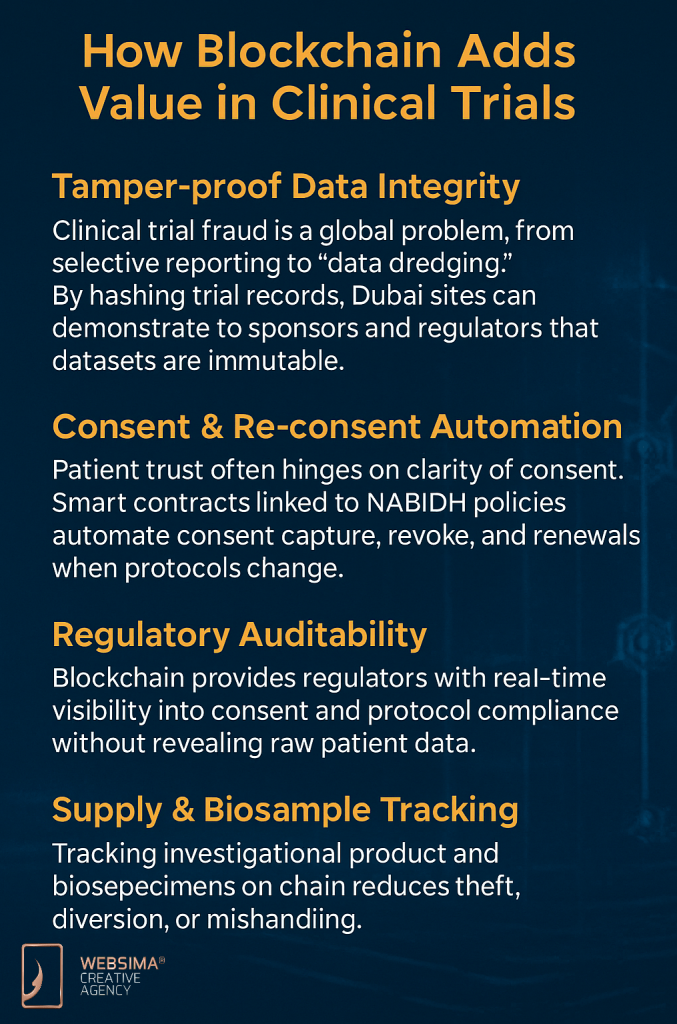
- Tamper-proof Data Integrity
Clinical trial fraud is a global problem, from selective reporting to “data dredging.” By hashing trial records, Dubai sites can demonstrate to sponsors and regulators that datasets are immutable. - Consent & Re-consent Automation
Patient trust often hinges on clarity of consent. Smart contracts linked to NABIDH policies automate consent capture, revoke, and renewals when protocols change. - Regulatory Auditability
Blockchain provides regulators with real-time visibility into consent and protocol compliance without revealing raw patient data. - Supply & Biosample Tracking
Tracking investigational product and biospecimens on chain reduces theft, diversion, or mishandling.
Blockchain in Life Sciences & Health (PDF)
eRx on Chain: End-to-End Prescription Traceability
Dubai already has strong eRx foundations:
- DHA ePrescription Integration. Official guidelines define how controlled medications are prescribed across authorities.
DHA ePrescription Integration (PDF) - eClaimLink / DHPO ePrescription Initiative. Circulars outline how providers submit e-prescriptions and receive coverage feedback.
eClaimLink ePrescription Circular (PDF)
Blockchain eRx flow:
- EMR issues the prescription.
- Hash + metadata are recorded on chain.
- Pharmacy dispense event adds a second record.
- Payer adjudication anchors a third.
This creates triple-entry accountability.
Benefits by Stakeholder
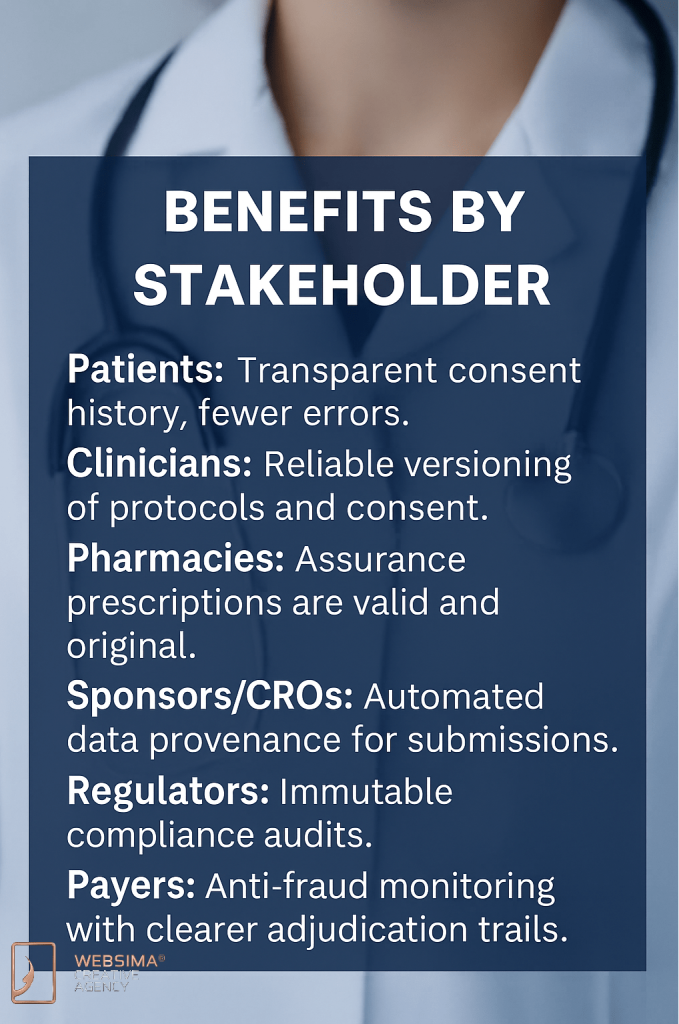
- Patients: Transparent consent history, fewer errors.
- Clinicians: Reliable versioning of protocols and consent.
- Pharmacies: Assurance prescriptions are valid and original.
- Sponsors/CROs: Automated data provenance for submissions.
- Regulators: Immutable compliance audits.
- Payers: Anti-fraud monitoring through AI in blockchain in Dubai with clearer adjudication trails.
Architecture Patterns
- Permissioned Ledger + HIE Integration. PHI stays off-chain, hashes stored on-chain.
- Verifiable Credentials for Consent. Revocable, portable consent tokens managed on chain.
- Event-Sourced eRx Trail. Anchors at issue, dispense, and claim stages.
Risks & Challenges
1. Regulatory Alignment
Every smart contract must reflect NABIDH consent standards. Misalignment risks invalidating entire trials.
2. PHI Leakage
A single mishandled integration could expose sensitive health data. Best practice: only hashes go on chain.
3. Integration Overhead
Dubai has dozens of EMR vendors and pharmacy systems; interoperability takes months of middleware engineering.
4. Training & Change Management
Even the best systems fail if clinicians, site staff, and pharmacists revert to “shadow IT.”
5. Vendor Lock-in
Choosing closed ecosystems now risks massive migration costs later.
6. Ledger Performance
High-volume eRx and trial events can congest a ledger. Layer-2 scalability patterns are essential.
Mistakes to Avoid
- Designing blockchain before consulting DHA/MOHAP regulators.
- Storing patient PHI on chain.
- Ignoring pharmacy/payer workflows.
- Skipping re-consent protocols.
- Underestimating role-based access mapping.
Implementation Costs & Fees
- Regulatory mapping: AED 150k–300k
- Pilot build: AED 500k–1.5M
- EMR/pharmacy/payer integrations: AED 300k–800k
- Audits & validation: AED 150k–350k/year
- Ongoing run costs: 10–15% of build
Case Study (Illustrative): Oncology Trial in Dubai
Context: Phase II oncology trial across three hospitals and two affiliated pharmacies.
Challenges:
- Delays in re-consent after protocol amendments.
- Reconciliation gaps in eRx, dispenses, and claims.
- Monitors spending too much time on data validation.
Solution:
- Consent DApp aligned with NABIDH.
- eRx anchoring at issue, dispense, and claim stages via eClaimLink.
- CRF hashes stored on chain.
Outcomes:
- Re-consent turnaround dropped from 10 days to 48 hours.
- 30% reduction in monitor queries.
- Two attempted duplicate prescriptions flagged early.
Lessons Learned:
- Governance policies must precede tech rollout.
- Training pharmacists was as critical as training investigators.
- Integrating payers accelerated fraud detection dramatically.
Global Benchmarks: How Dubai Compares
- EU: The EMA has begun evaluating blockchain pilots for pharmacovigilance, but adoption lags.
- US: FDA’s “DSCSA” mandates drug traceability by 2024, some blockchain pilots exist but fragmented.
- Asia: Singapore and South Korea are testing blockchain consent models in tertiary hospitals.
Dubai’s edge: A unified national/federal HIE (Riayati) and emirate HIE (NABIDH) already exist, making blockchain easier to integrate than in countries with fragmented healthcare systems.
Future Outlook: 2025–2030
- Policy convergence: NABIDH and Riayati rules will harmonize.
- AI integration: Automated anomaly detection in trial data.
- CBDCs in healthcare: UAE Digital Dirham may be used for instant settlement of claims.
- Privacy-preserving analytics: Zero-knowledge proofs on trial endpoints.
- IoT-enabled cold chain: Integrating blockchain with IoT for Real-time investigational drug monitoring.
FAQs
- Is blockchain allowed in Dubai healthcare?
Yes—if compliant with NABIDH and MOHAP standards. - Does blockchain store PHI?
No, only metadata and hashes. - How does blockchain reduce prescription fraud?
Immutable records at issue, dispense, and claim stages make fraud traceable. - Can patients revoke consent?
Yes, NABIDH-based policies ensure revocations are logged immutably. - How long does a pilot take?
Typically 12–20 weeks. - Which ledger models work best?
Permissioned systems like Hyperledger Fabric with channel privacy. - What KPIs matter most?
Re-consent speed, monitor queries, duplicate script detection. - Are insurers involved?
Yes—through eClaimLink adjudication touchpoints. - What are the biggest risks?
Policy misalignment and PHI leakage. - How does Dubai compare globally?
Dubai’s unified HIEs give it an adoption advantage over most markets.
Final Thoughts
Dubai’s health sector is already among the most digitally advanced in the Middle East. By layering blockchain onto existing rails like NABIDH and Riayati, healthcare providers, regulators, and pharma companies can build a new level of trust, transparency, and accountability in clinical trials and e-prescriptions.
The journey will not be without challenges—privacy safeguards, integration overhead, and training requirements remain significant—but the upside is transformative. Dubai is not only setting a regional precedent; it is positioning itself as a global benchmark for blockchain-enabled healthcare.
Websima: Build Your Healthcare Blockchain the Right Way
At Websima, we deliver blockchain solutions tailored for healthcare providers, regulators, and pharma innovators in Dubai. Our expertise includes:
- NABIDH/MOHAP regulatory alignment
- Consent and eRx blockchain pilot builds
- EMR/pharmacy/payer integrations
- Vendor selection and architecture
- Audit readiness and training
Ready to deploy blockchain in healthcare? Contact Websima today.

